Among everyone’s favorite wildlife (and insects) are butterflies. The drought last year meant little for butterfly larvae to eat, and thus few butterflies early in the year (and those we had were markedly smaller than the previous year.) But the rains over a month ago made it possible for some wanderers to lay eggs, and those eggs to survive, hatch, and the larvae to pupate…so now we have more butterflies.
I can’t get good pictures of the fast-flying species of sulfurs who are our dominant types, nor did I catch the big tiger swallowtail in the back yard, but here’s some of what was flying (and cooperative about photography) in the past week.
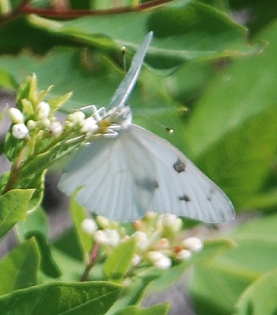
This Checkered White is trying to nectar on dogbane (the flowers mostly still in bud.)
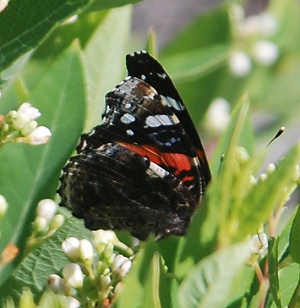
This beautiful, fresh Red Admiral was busy in the same patch of dogbane.
Prairie bluets, which are pink to white (but related to bluets that are in fact blue) attract different butterflies, here a Reakirt’s Blue, which is blue only on the upper side of the wings:
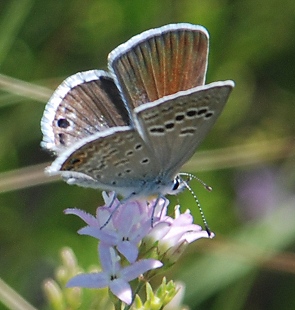
These guys are tiny–thumbnail size–but like all the hairstreaks and groundstreaks, very beautiful. So here’s another view, with the blue color near the body just showing–in flight, they “flicker” blue.
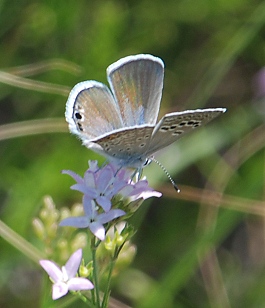
Finally, as I went through the creek woods, a very fresh Monarch flitted past me (probably disturbed from its resting place, as it immediately found another) and posed in a shaft of sunlight:
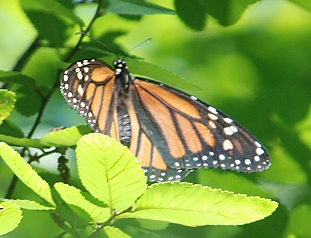
The color was even richer than shows here; the angle at which I had to take the picture and the sun angle, created some reflection-flare that paled out the rich orange.
Many people don’t think of butterflies as “wildlife” or recognize their ecological importance…but they’re part of the web of life that sustains us. Nectar-eating adults may help pollinate some plants; butterfly larvae consume some plant materials and their frass provides both finely-divided fertilizer and food for other organisms. They are parasitized by other, smaller, organisms as well…which prevents us being overrun by, say, Monarchs. Just trying to make an accurate map of the interactions of even one species (such as the Checkered White) that includes all its parasites and predators, all the plants it uses at all stages of its life, etc, etc., is a daunting prospect.
Comment by Barb — May 31, 2009 @ 8:14 am
Ooohhhh, so lovely, especially the Reakirt’s Blue.
Comment by elizabeth — May 31, 2009 @ 9:46 pm
The upper wing surface sort of shimmers in the light–as you can see, some parts look coppery, and then the blue shows and the colors together are incredible.
Comment by cdozo — June 1, 2009 @ 10:05 am
Nice pictures of some beautiful butterflies.
Comment by elizabeth — June 1, 2009 @ 10:17 am
I would be out there trying to find more, but I’m waiting for a business call. About to call again and see if I can get a time-frame, because I need to take something over to John’s ranch.
Comment by Rosanne — June 13, 2009 @ 8:28 pm
I planted parsley for the local swallowtails, and I saw one checking out that bed, but between the two bouts of hail and the days of 105-107 degree temps, I haven’t seen any caterpillars 🙁
I haven’t inspected the parsley closely, for fear I might brush off eggs.
Comment by elizabeth — June 13, 2009 @ 9:15 pm
Weather is not cooperating, that’s for sure.